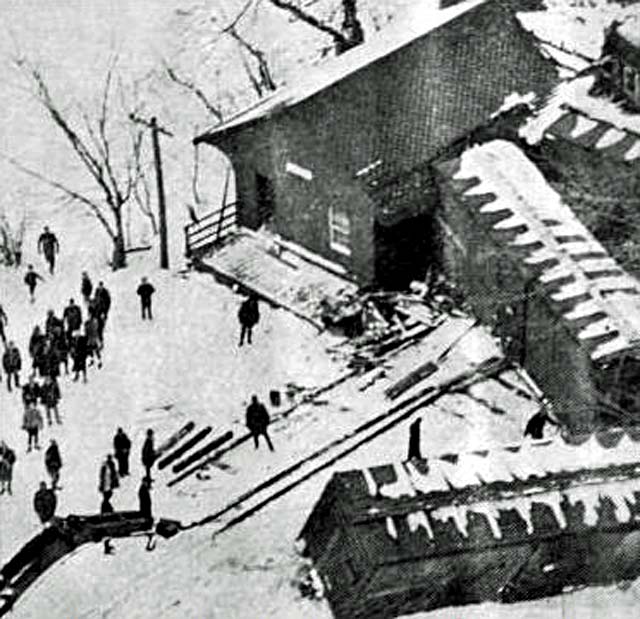
2012
|


Derailed box cars have struck the Ashton train station - Date/Photographer unknown.
22 March 2012
Collision of Freight Trains at Ashton on 18 Mar 1950
Ashton Ontario - March 18 was unseasonably warm this year, one day in an extended warm period that has seen most of the snow disappear
from the landscape. But March 18 has not always been so lamb-like. Indeed, back in 1950, it was a March lion, with a blinding snow storm hitting the
Stittsville and Goulbourn area.
And it was in this blinding snow storm that a fatal and tragic collision between two freight trains happened right at the Ashton train station. Two of the
freight cars were thrown into the Ashton station, track was torn up for more than 200 yards, the area was littered with splintered ties and twisted steel
rails, and, most tragic of all, two railway employees died.
This all happened about 1:15 a.m. on Saturday, 18 Mar 1950, with a blinding snowstorm taking place.
An extra eastbound freight train from Smiths Falls was pulling into the passing track at Ashton. At the time of the collision, its engine, tender, and several
freight cars were already on the siding but the remainder of the freight train, some 15 cars, was still on the main line when a westbound freight train on that
main line sliced into these freight cars.
The impact from the westbound engine slamming into these cars threw two of them against the Ashton station, after which the engine toppled end over end,
tearing up track.
Two men on this westbound train died in the collision. One was the engineer who was found half buried in the snow while the other was the fireman who was found
in the wreckage of the cab. Two others were injured.
The contents of the damaged freight cars were scattered about the site. One had a cargo of beer while another had a load of ladies' sample shoes, all for the
same foot.
A later coroner's jury, held in Carleton Place to look into the cause of the collision, did not declare any identifiable cause for the crash. However,
confusion in the orders to the crews of these trains and poor visibility due to the snowstorm were both cited as contributing factors.
And the situation could have been even worse, and possibly more tragic, had it not been for quick action taken by Percy Illingsworth, the station agent at
Stittsville, that night.
A westbound Montreal-to-Vancouver passenger train had left the Ottawa West station before news of the collision was received there. It was thus racing toward
Stittsville and beyond that Ashton, with its operators unaware of the fright cars littering the track there.
Mr. Illingsworth, who had been notified by phone of the situation with regards to this approaching train, pulled some clothes over his pyjamas, grabbed a
flashlight, and dashed through the snow drifts to reach the train track. Visibility was poor because of the heavy snow storm but when he saw the glimmer of the
headlight of the approaching train through the swirling snow, he started signaling with his flashlight for the train to stop. Fortunately, the engineer on the
train saw and understood the signal and the passenger train stopped. Had Mr. Illingsworth not taken his action or if his signal had not been seen, this
passenger train would have roared into the Ashton station and its carnage with who knows what kind of disastrous and tragic results.
Percy Illingsworth served as the station agent at Stittsville for about 20 years, succeeding the famous A.G. Appleby who was termed "the governor"
for his leadership in the community.
Craig Hobbs was the last station agent to serve at Stittsville, holding the position from 1962 to 1968. After that, the station was closed, the land sold, and
the building was removed in 1969.
There were extensive tracking systems for the railway at both the Stittsville and Ashton stations. The station at Ashton was on the south side of the track,
just west of the Goulbourn/Beckwith town line road. Indeed, the station platform extended to within a few feet of the townline road.
There were switches and a siding at the Ashton station as well as stock yards used by local farmers for when they shipped their cattle to market. In the early
1900's, horses were frequently housed in these stock yards as farmers shipped them out west.
The Ashton station at harvest time also witnessed lineups of farmers with their teams of horses and wagons full of grain, waiting to deposit their loads in
waiting freight cars.
The Ashton station handled both passenger and freight traffic and was as telegraph office as well.
The train was a vehicle for travel, not only by individuals and by students attending high school in Carleton Place, but also for groups such as Loyal Orange
Lodge members travelling to special events. In 1872, for instance, just two years after the rail line was opened, members of the Stapleton Orange Lodge No. 471
west of Richmond travelled to the Ashton station in order to catch the train into Ottawa for a 12th of July celebration.
The 1981 book "Remembering Our Railway" by the late Grace Thompson of Stittsville, which outlines the history of the railroad in Stittsville and also
Ashton, features a cover photo of the 1950 Ashton train wreck as published in the former Ottawa Journal on 20 Mar 1950. This book, which can be found in the
reference section at the Stittsville branch of the Ottawa Public Library, remains the most authoritative published account not only of Stittsville's railway
history but also this tragic train crash at the Ashton station on 18 Mar 1950.
John Curry.

|

